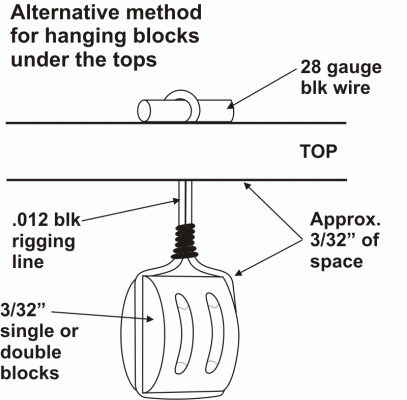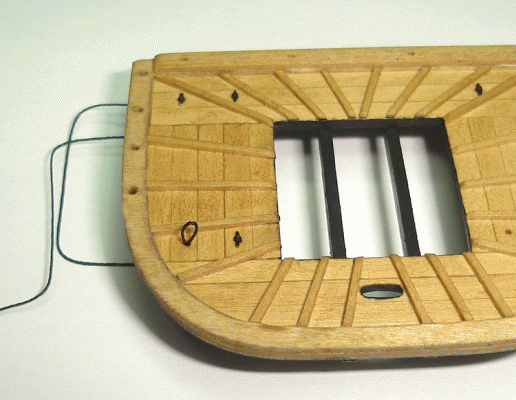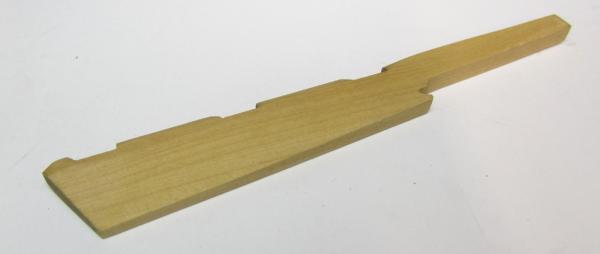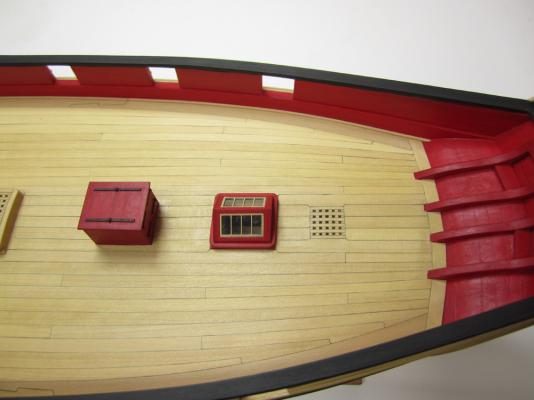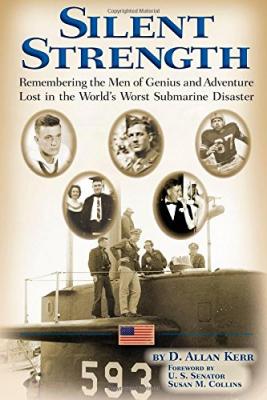-
Posts
9,449 -
Joined
-
Last visited
Content Type
Profiles
Forums
Gallery
Events
Everything posted by Chuck
-
That looks very good Mike. I cant wait to see it in person.
- 452 replies
-
- cheerful
- Syren Ship Model Company
-
(and 1 more)
Tagged with:
-

2015 NRG Conference Update - MYSTIC
Chuck replied to Chuck's topic in NAUTICAL RESEARCH GUILD - News & Information
What a wonderful few days indeed...... Ben, Duff, Rusty, Druxey, Ron, Mike, Ryland and so many others from MSW...It was great to spend time with all of you and chat. Now its time to start working on Next years Conference in San Diego . Get ready Chuck -
Thank You....if you are ever in th e neighborhood let me know.. I love getting company during the day.
- 1,051 replies
-
- cheerful
- Syren Ship Model Company
-
(and 1 more)
Tagged with:
-

Cutter Cheerful 1806 by rafine - FINISHED
Chuck replied to rafine's topic in - Build logs for subjects built 1801 - 1850
nicely done- 525 replies
-
- cheerful
- Syren Ship Model Company
-
(and 1 more)
Tagged with:
-
Don....why not actually start a build log of your own. I do think it would be much better and so not to have kinda to builds going on in one topic. I think it would be easier to ask your questions that way. We would all love to see your Washington develop and progress. Chuck
- 504 replies
-
- washington
- galley
-
(and 1 more)
Tagged with:
-

2015 NRG Conference Update - MYSTIC
Chuck replied to Chuck's topic in NAUTICAL RESEARCH GUILD - News & Information
The conference is just two weeks away!!!! I just wanted to let folks know to be sure to visit the NRG registration table when you arrive. Get your name badges and welcome packet. Your name badges will get you free entry into Mystic Seaport for the entire duration of the conference including Wednesday I believe. So you will be able to come and go as you please. Even though the seaport is just a mile and half from the hotel, you will certainly need a car. Although I am sure somebody will get you there with over 175 folks signed up for the conference. There will be plenty of model builders there. I wish everyone a safe and comfortable trip and I hope to see you there soon!!! -
Thanks!!! To my knowledge nobody sells blackened eyebolts commercially. I wish I could make them from the acrylic I make my hooks out of, but the acrylic doesnt like any type of glue and it simply wouldnt work. Best to just use 28 gauge black annealed wire to make your own eye bolts from scratch. Chuck
-
Guys All I can say is that I am careful and slow to a fault. Its tough to get stuff done this way. But I do agree everyone should just slow down. Its what I recommend a lot of folks to do... Anyway...back to Cheerful. I was able after two attempts to shape the boom crutch and create a procedure for doing so. The key was starting with a much thicker piece and making the boom crutch a bit over-sized to start. I cut out the boom crutch on a piece of 1/4" thick boxwood and carefully adjusted for three angles. When completed it will be just 1/8" wide to match the width of the fashion piece. Now that the starboard side is complete I can do the other and take pictures at every step. This is certainly one piece that needs slow and attentive care to the angles involved. The boon crutch must be turned inboard slightly so the boom can actually sit in it. This is tough because the fashion piece and the side of the hull goes in the opposite direction!!! This one piece took me over four hours to produce, shape and paint to a finish I found acceptable. A few careful reference marks and filing...then turn the piece inward and you are good to go!!! I will have a step by step soon. You can see the second boom crutch over-sized and ready to shape in one of the photos. Note the tail is left long so the proper angles can be created while sanding it shorter. Because the boom crutch was painted black it might be hard to see in these photos but essentially the boom crutch must match the angle of the fashion piece when viewed from the side and from astern in two planes while being turned to line up with the path of the boom (or the main mast). All while hiding the seam between the two pieces...thank God it is supposed to be painted black.
- 1,051 replies
-
- cheerful
- Syren Ship Model Company
-
(and 1 more)
Tagged with:
-
Magic!!! Seriously I have no idea...I just work very slooooowly. Drives others nuts when they watch me working on something.
- 1,051 replies
-
- cheerful
- Syren Ship Model Company
-
(and 1 more)
Tagged with:
-
Timberheads are completed....now on to the boom crutches. Just a word about those boom crutches. These are probably some of the trickiest parts of the model to make. There are going to be some crazy angles to create and much trial and error. I expect to make quite a large pile of bad boom crutches. This is for the benefit of all those building the model as well. You will no doubt have a large pile of discarded crutches also. I will do my best to explain how I make them step by step.
- 1,051 replies
-
- cheerful
- Syren Ship Model Company
-
(and 1 more)
Tagged with:
-

Block layout for Syren foremast and mainmast tops
Chuck replied to Stringer52's topic in Masting, rigging and sails
-
Thanks Dan....hope to see you soon...maybe in a few weeks at the conference??
- 1,051 replies
-
- cheerful
- Syren Ship Model Company
-
(and 1 more)
Tagged with:
-
Most were just edge bent...the hooked scarfs were cut from wider stock than the 3/16" strips and then they were edge bent too!!! Chuck
- 1,051 replies
-
- cheerful
- Syren Ship Model Company
-
(and 1 more)
Tagged with:
-
No not yet. That is months away I am afraid. I am using MinWax Wipe-On-Poly for the finish. Nothing else. Started on the timber heads today. There are only six. No shortcuts here. Just grab a sharp blade and start shaping. I know some folks use power tools for this but I prefer to go old-school. I just go very very slow. They are 3/32" thick. Chuck
- 1,051 replies
-
- cheerful
- Syren Ship Model Company
-
(and 1 more)
Tagged with:
-
I created the rudder port by flipping the hull upside down. I made a pilot hole and slowly opened it up and shaped it. I made the rudder first which is shown below. This was used to test the size and shape of teh port and when I was satisfied I touched up the red paint around it. Then it was time to add the small top section of the rudder post. I designed the model so it was simulated and put on in two pieces. The laser cut longer piece is shown in the same photo below. I left a longer tail so folks can sand it down to fit their models. The deck level will probably vary model to model and this takes care of the issue. Once filed down to fit, it was glued into position and painted. To pull off the illusion I used yellow glue which sets up slower. By having the rudder made I was able to tape it in position so I could get the correct angle for this tiny piece. This step was crucial. It was tweaked while the rudder was taped on temporarily. The yellow glue gave me a lot of time to move it around so it was positioned correctly and creates the illusion of a one piece stern post. A little sanding on the outboard edge and some filler and it looked really good after painting. I still havent decided if I will paint the inboard portion of the rudder head. I probably will as is stands out too much left bright. And finally....I made some time to paint the windlass. I havent glued it into position yet but here are some overall detailed photos.
- 1,051 replies
-
- cheerful
- Syren Ship Model Company
-
(and 1 more)
Tagged with:
-
Thank You.....I am not sure I understand what photo spars is. Can you clarify? I will certainly help you any way I can. Chuck
- 1,051 replies
-
- cheerful
- Syren Ship Model Company
-
(and 1 more)
Tagged with:
-
Yes indeed...on each end...I have seen some folks use 6 or seven and sometimes more at each end. It just wouldnt be the case. Its usually because they don't taper the planks to curve them. If you use straight planks then you may well be forced to use many more which is why they usually tapered them. I also find that they start the nibbing process too soon. It usually isnt needed till the margin plank turns down the sides of the bulwarks further aft then most start.
- 1,051 replies
-
- cheerful
- Syren Ship Model Company
-
(and 1 more)
Tagged with:
-
I agree that both methods were used. until around 1825-30 when most decks were nibbed. Here is an image of a 1770's cutter. It is a contemporary model for sure. The deck is clearly nibbed. Both methods were used and its just a matter of picking which you prefer to model. I prefer the curved planks with hooked and tapered scarfs over the straight and nibbed. Although there was also curved and nibbed deck planking as well. Like everything else....its a matter of personal preference. Chuck
-
And finally....the deck is planked. This is a big milestone for me because it is the last really big messy job to be done. The remainder of the project will be small fittings and less sanding. There will be less dust and less paint touch up. The planking was pretty straight forward after having lined off the deck. I just following the plan I drew on the false deck. Each plank was tapered to match. The scarphed planks were handles much the same way the drop plank was on the outside of the hull. If I thought it was needed, I made a card stock template. The scarphed planks were cut from wider stock (7/32" or even 1/4" wide planks). Next I will create the rudder port because it will be the last time I can turn the hull upside down without too much trouble. Once that is done I will return outboard and finish off all of the details. The boom crutches, boarding ladders, scuppers and channels etc.
- 1,051 replies
-
- cheerful
- Syren Ship Model Company
-
(and 1 more)
Tagged with:
-

US Brig Syren by knightyo
Chuck replied to knightyo's topic in - Build logs for subjects built 1801 - 1850
That is looking very good Alan. Its fantastic to see you back in the workshop. Hope you are doing well. These are difficult pieces to shape and they look like they will work out very nicely. Chuck -
Yikes....That will indeed be hard to look at!!!!
- 209 replies
-
- cheerful
- Syren Ship Model Company
-
(and 1 more)
Tagged with:
-
The Fleet Book of the Alaska Packers Association, 1893-1945: An Historical Overview and List By Donald H. Dyal North Charleston: CreateSpace, 2014 8-1/2” x 11”, softcover, xvii + 208 pages Photographs, notes, index. $44.99 ISBN: 9781499329209 The last large American fleet of ocean-going sailing ships was that operated by the Alaska Packers Association, seasonally carrying workers from San Francisco Bay to the mouths of Alaskan rivers and creeks to can salmon. This salmon canning business was very lucrative, second only to lumbering on the West Coast in the late nineteenth and early twentieth centuries. The ships that made up this fleet were very miscellaneous. None of them was purpose-built for the Association; all were purchased, usually rather cheaply, after hard service lives of fifteen to twenty-five years in the worldwide oceanic trades. (It is worth remembering that fifteen to twenty-five years was regarded at the time as the usually working life for a merchant vessel.) Remarkably, most went on to provide twenty-five years or more of service with the Association’s fleet, despite the rigors of the Alaska canning trade. Donald H. Dyal set out to research the extant fleet books in the archives and consolidate the information they contained into a single comprehensive fleet listing that would tell the remarkable half-century story of these vessels (and their steam or diesel-powered fellows). The heart of the book comprises thirty-six individual “biographies” of the sailing vessels of the fleet. Each vessel’s origins are presented in tabular form, followed by a short history covering its operations prior to, during, and after service with the Association. Dyal also includes remarks on surviving artifacts from the vessels, two of which (Star of India and Balclutha) are preserved to this day as museum ships. The powered ships are treated much more briefly, as are those vessel chartered by the Association and the Liberty and Victory ships it operated during World War II. One of the most interesting features of this new Fleet Book is the author’s excellent summary of the history of the Alaska Packers Association that opens the work. This presents not only a chronological summary of the Association’s story but also material on the routine of its operations; both important to provide context for a fuller understanding of the industry and the vessels in its service. Overall, The Fleet Book of the Alaska Packers Association is an invaluable reference for both researchers and aficionados of the later days of oceanic sailing ships. It is packed with useful material and, equally importantly, replete with pointers toward sources for those interested in greater detail. Henry Farrar Baltimore, Maryland
-
Silent Strength: Remembering the Men of Genius and Adventure Lost in the World’s Worst Submarine Disaster By D. Allan Kerr Portsmouth, New Hampshire: Jetty House, 2014 6-1/4” x 9-1/4”, hardcover, xvix + 124 pages Photographs. $29.95 ISBN: 9781937721190 Silent Strength (which takes its name from the motto of USS Thresher) is a compilation of articles by D. Allen Kerr published during 2013 to commemorate to fiftieth anniversary of the boat’s loss as tributes to the men who served aboard the submarine. As such, it does not concentrate heavily on the design or construction aspects, nor on details of Thresher’s loss, but more on its legacy. From an operational perspective, Thresher’s most important legacy (as Kerr notes frequently) was the development and implementation of SUBSAFE: the Navy’s quality assurance program designed to maintain the safety of the nuclear submarine fleet. Thresher also was the lead boat for the fleet’s advanced attack submarines designed to hunt down and overcome the Soviet Union’s expanding nuclear submarine force through speed, silence, deep-diving ability, and the deployment of advanced technologies. Thresher’s human legacy is the lives of the 129 sailors lost in this tragic disaster. The story of many of their lives is the central element of Kerr’s book. Kerr’s skillful writing brings out, over and over again, the accomplishments of seemingly ordinary men, from a whole range of social and educational backgrounds, who came together as a cohesive team to operate this submarine that was on the cutting technological edge of its time, thanks to training, dedication, enthusiasm, selflessness, and commitment. This is a fascinating exploration of the often obscure nature of the submarine service’s social history. Silent Strength’s melding of operational and technical history with evocative retellings of the lives of Thresher’s crew is a wonderful tribute to these men. Michael O’Brien Tampa, Florida
-
Submarine Torpedo Tactics: An American History By Edward Monroe Jones and Shawn S. Roderick Jefferson, North Carolina: McFarland and Company, 2015 6” x 9”, softcover, viii + 221 pages Photographs, diagrams, notes, bibliography, index. $45.00 ISBN: 9780786496464 During two world wars, the menace of submarine warfare against merchant shipping loomed large in naval strategic and tactical discussions. Germany’s U-boats came extremely close to forcing the Allies to the negotiating table during World War I and were a major threat to Allied success in World War II. How ironic it then is that the single incontestably successful submarine campaign against merchant shipping should have been that of the United States Navy against Imperial Japan in World War II. Submarine Torpedo Tactics lays out, in a wonderfully readable manner, the story of this evolution in the United States Navy from just before World War I to the present (within the limits of information publically accessible). The authors bring together a vast array of material, much of which has been published previously in snippets but never before presented together in such a coherent format. The net result is probably the best explanation yet of how submarine attacks have been and are now conducted. If a reader wants to know why American submarines were so successful in their assault on Japan’s shipping during World War Ii and they proposed to keep Soviet ballistic missile submarines at bay during the Cold War, this is the place to find the answers. Of necessity, the requirements of their thesis obliged the authors also to explain the development of submarine design in the United States. Their success is such that Submarine Torpedo Tactics may well be the best short outline of this process yet in print. It is concise, it highlights the major milestones, and it presents sufficient technical detail to make its case without overwhelming the non-specialist reader with esoteric terminology or concepts. Submarine Torpedo Tactics also includes a major bonus in the form of stories illustrating the lives of the operators, ranging from the antics surrounding theft of a totem pole by crewmen from the missile boat Growler through the installation (and use) of a Steinway grand piano aboard the attack submarine Sturgeon to vivid descriptions of underwater gyrations by American and Soviet submarines during the Cold War. Though short (in light of the magnitude of its topic), Submarine Torpedo Tactics displays excellence on so many levels. anyone—academic, lay researcher, or simply interested reader—can only learn from this most enjoyable and informative study. Steven Fitzgerald Wilmington, Delaware
About us
Modelshipworld - Advancing Ship Modeling through Research
SSL Secured
Your security is important for us so this Website is SSL-Secured
NRG Mailing Address
Nautical Research Guild
237 South Lincoln Street
Westmont IL, 60559-1917
Model Ship World ® and the MSW logo are Registered Trademarks, and belong to the Nautical Research Guild (United States Patent and Trademark Office: No. 6,929,264 & No. 6,929,274, registered Dec. 20, 2022)
Helpful Links
About the NRG
If you enjoy building ship models that are historically accurate as well as beautiful, then The Nautical Research Guild (NRG) is just right for you.
The Guild is a non-profit educational organization whose mission is to “Advance Ship Modeling Through Research”. We provide support to our members in their efforts to raise the quality of their model ships.
The Nautical Research Guild has published our world-renowned quarterly magazine, The Nautical Research Journal, since 1955. The pages of the Journal are full of articles by accomplished ship modelers who show you how they create those exquisite details on their models, and by maritime historians who show you the correct details to build. The Journal is available in both print and digital editions. Go to the NRG web site (www.thenrg.org) to download a complimentary digital copy of the Journal. The NRG also publishes plan sets, books and compilations of back issues of the Journal and the former Ships in Scale and Model Ship Builder magazines.













